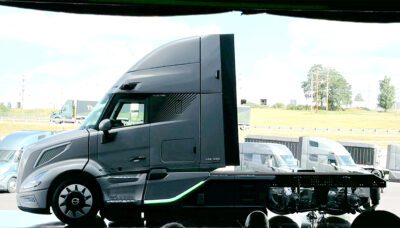On a recent sunny June day in Virginia’s scenic New River Valley, a new $400 million factory came to life, performing test runs of its production equipment for the all-new Volvo VNL truck. This was the first synchronized run, with all the automated assembly systems running in unison — 140 robots welding together the high strength steel cab and dipping the finished body in an electrochemical coating process to reveal the first mass-produced body-in-white versions of the all-new Volvo VNL. I was there to witness the first day of “all systems go,” and it was impressive to see everything turned on and integrating the distinctive new wedge-shaped cab.
While the new cab plant takes advantage of automation to meet exacting standards for precision and consistency, there are also plenty of hard-working Volvo Trucks employees. A few hundred yards away, we were able to see the main assembly plant, which has produced the legacy VNL trucks for many years, and the 3,600 workers at the plant are preparing for the big switch late this summer, when the all-new VNL will go into mass production, marking the company’s first completely new truck since 1996.
The aerodynamic look of the new truck is the real eye-catching change, but one of the most notable changes for the updated model is the use of more integrated subsystems, for example, the battery energy module, with its new high-power capacitor to enable engine starts even when the battery is low on juice. Subassemblies like this are brought to the line ready to be added, improving the manufacturability of the new truck. In a similar change, new optimized option packages make it easier for dealers and customers to spec the truck and simplify the manufacturing operation.
The truck is the culmination of about six years of R&D, including integration of key concepts from the SuperTruck II project. Improved aerodynamics, along with a host of improvements to the drivetrain and chassis, resulted in a 10% fuel efficiency gain, world-leading safety systems, and a more comfortable cabin for the driver. There are several engine upgrades that contribute to the increased fuel efficiency and reduced emissions, including new piston head design, new connecting rod geometry and variable vane oil pump that reduce friction and improve combustion. The new VNL is also a well-connected truck, giving fleet managers a new suite of tools to monitor their trucks to maximize uptime and stay a step ahead of any issues that can impact their businesses.
On the test track, it’s easy to notice the fast-shifting transmission, quiet and smooth ride, and lane centering assistance, which makes driving noticeably less stressful, eliminating the guesswork in holding the line in a corner. This feature, part of the Volvo Dynamic Steering package, reduces mental fatigue and increases driver confidence, especially when we factor in pedestrian detection and other features of Volvo’s Active Driver Assist package, such as holding safe following distances.
What is perhaps hardest to convey is the pride that Volvo Trucks workers take in the new truck, and the smile on their faces and they explain how each innovation delivers a better experience for drivers and fleet managers. Filling the trucks with renewable diesel is the final touch, as these trucks prepare to make their way from final assembly to hauling freight on the open road.
The all-new VNL will also be Volvo Trucks’ platform for future innovation, and as a preview, the company surprised attendees with a brief look at a prototype battery-electric VNL with e-axles, which aligns with the company’s three pillar approach of electric, hydrogen, and renewable fuels all contributing to the company’s decarbonization targets.

Attendees got a glimpse of a prototype battery-electric VNL with e-axles.
We make it our business to follow the progress of sustainable transportation, and the 10% fuel economy improvement and future sustainable drivetrains for the new VNL platform are solid progress for the industry.



